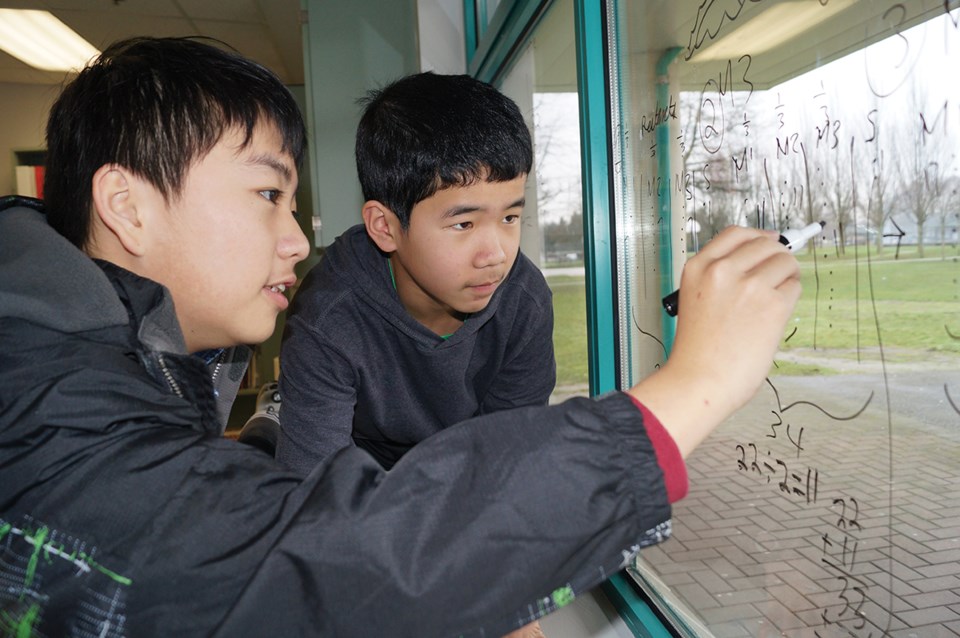How students are tackling mathematics is like an evolving animal.
Teachers across the Richmond School District, such as Ingrid Veilleux and Gillian Ewart, say they are taking the anxiety out of math by focusing on communication and problem-solving skills, as opposed to traditional rote learning during math class.
“Math research is showing it’s effective to use rich math problems — challenging problems,” said Veilleux, a Grade 7 French immersion teacher at McNeely elementary school.
While a math problem may take an entire class to solve the objective, said Veilleux, it allows students to interact with one another and solve complex problems.
Another important aspect of the new-age learning methods is having students work with different partners each week.
“The kids work in random pairs and aren’t sorted by abilities or friendships necessarily,” said Veilleux, adding that her kids are less likely to fall into traditional roles and thus begin to understand that people think differently.
Doing so gives everyone the opportunity to be placed in a different learning role. So, gone are the days of the teacher modelling one problem and having students repeat that model 20 or so times.
“We don’t do so much ‘drill and kill’ stuff anymore, but they certainly still need to understand the basics, like memorizing the times table,” said Veilleux.
As district teacher consultant Janice Novakowski explains: “We are moving towards a redesigned curriculum in British Columbia, not just in mathematics but in all curricular areas, that is focused on more personalized inquiry-based approaches and is competency-based.”
With so much information at our fingertips these days the focus toward problem solving only makes sense, said Novakowski.
“Students need to be able to think, to reason, to problem solve. Students need strong estimation skills, fluency with numbers and to make sense of data, statistics and graphs.”
Novakowski is supporting 16 schools this year, which are pursuing mathematics-focused professional learning with many teachers involved in collaborative, inquiry-based projects.
In December, she facilitated a math-focused professional development day with more than 200 teachers attending from across the district.
Part of this process means finding new ways for students to learn math.
Ewart’s Grade 5/6 class just down the hall from Veilleux’s, is using digital tablets to have students explain their math problems.
For example, using various apps, the students can create audio recordings and drawings of a problem.
“For them to go through the process of explaining it, it forces them to understand the math problem,” said Ewart.
The process takes time, she added.
“It takes a fair amount of understanding, rather than the repetitive nature of older teaching methods.”
Novakowski said this kind of learning allows for students to actually understand the nature of the problem.
“Some may argue that knowing and understanding the math isn’t necessary, but I disagree,” she said.
Part of that understanding is giving students the opportunity to make a mistake.
One teaching method that helps with this aspect is learning on white boards, chalk boards, and even windows.
Veilleux is applying this “vertical learning” method in her classroom. Think of it as a sort-of old school twist on a new-age process, she said.
Students are paired up and encouraged to draw on boards or windows (with erasable felts, of course). The goal is to make students feel comfortable with making a mistake, as learning research has shown that making mistakes with pens and pencils on paper discourages students because the mistake seems more permanent. An easy-to-erase mistake means kids can move forward more easily, as opposed to dwelling.
“There are many ways to work with numbers and we want students to be fluent and flexible thinkers. When mathematics is seen as something that is flexible and open, students are drawn in and determined to figure things out in their own way,” explained Novakowski.
The end goal, for all teachers, is to make any subject, including the formerly dreaded math class, fun and joyful, she said.



